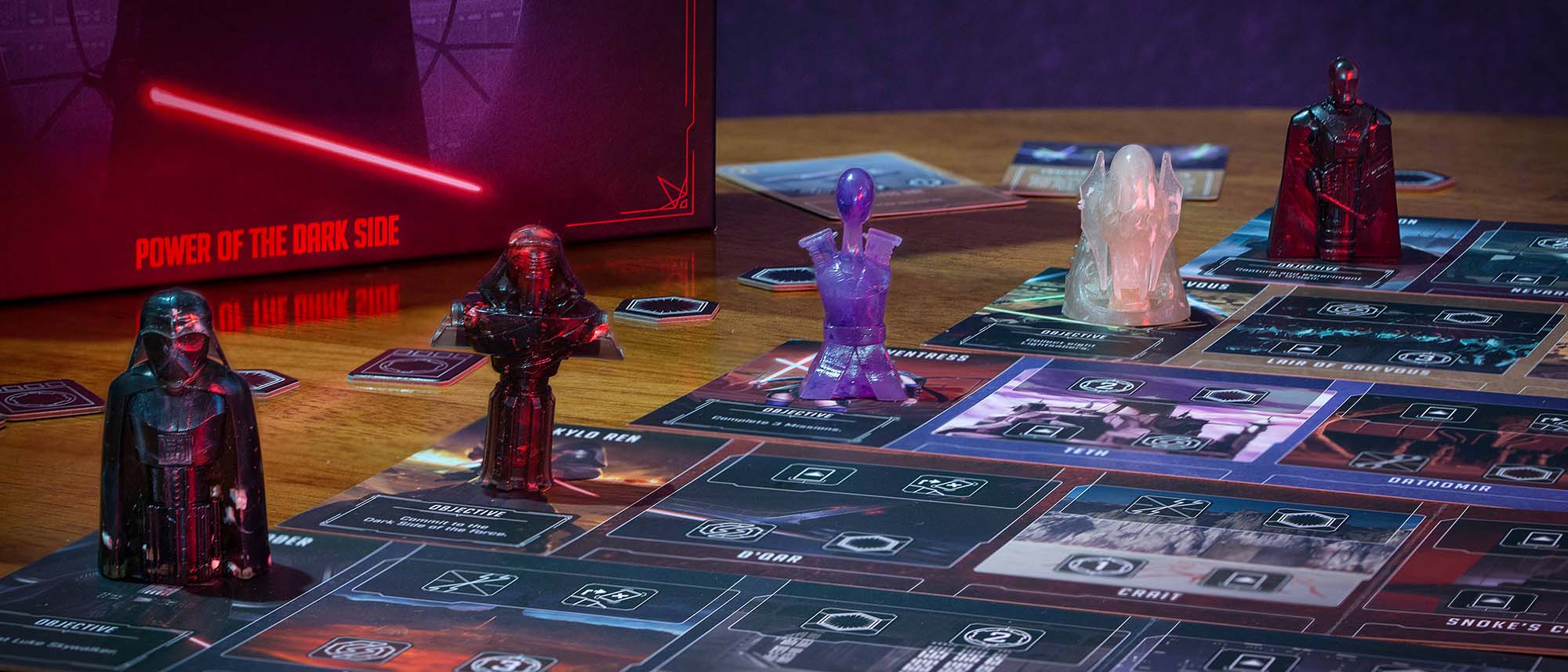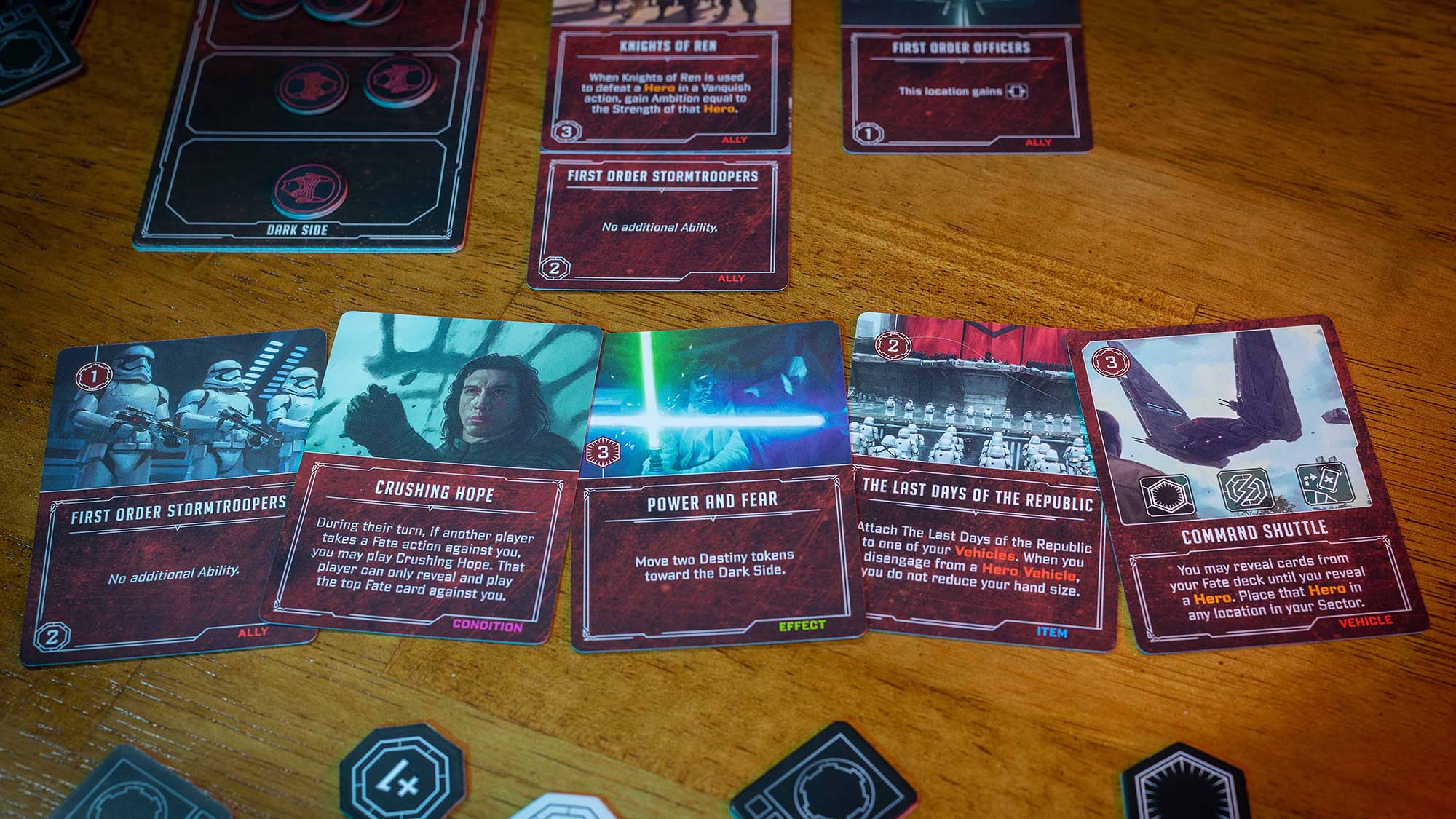Space Verdict
If you’re a Star Wars fan who’s never played a Villainous game before, there’s no better place to start, and even if you’re not completely sold on the Star Wars theme, the new mechanics make this a must-have for Villainous aficionados too. Ambition Tokens and Vehicle Cards add an extra layer of depth without compromising the series’ accessible yet surprisingly deep core mechanics, and the five playable villains are different and enjoyable enough to keep your dark side satisfied until the inevitable expansions.
Pros
- +
Vehicles are a great new addition
- +
Star Wars suits the Villainous formula
- +
Each villain is different and fun to play
- +
Villains are generally well balanced
Cons
- -
Attractive movers let down by lacklustre execution
- -
Artwork-only cards with no film stills would have been preferred
Why you can trust Space.com
Price: $39.99 / £34.99
Type: 10497
Players: 2-4
Recommended age: 10+
Time per game: 40 minutes
Complexity: 6/10
If you’re the kind of cold-hearted individual who had hoped Mando would carbon-freeze Baby Yoda and hand him over to The Client or that Darth Vader had lobbed Luke into the Death Star’s reactor shaft, then Star Wars Villainous is the board game for you.
Star Wars boasts a most impressive roster of licensed tabletop games that can compete with the best space board games out there, and Star Wars Villainous is no different. It’s the latest core game in the much-loved Villainous series that launched in 2018 with Disney Villainous and subsequently Marvel Villainous (2020) alongside a plethora of expansions.
Just like its predecessors, players are tasked with helping their villain carry out nefarious deeds in a race to complete a predetermined set of wrongdoings before anyone else. But while each player is working towards their own goals, they’re also trying to upend the opposition’s evil plans in the process by sending various characters from across the Star Wars universe into the breach.
Existing players might wonder if this is simply a rehash of the tried-and-tested formula, set in a galaxy far, far away. But just like Marvel Villainous, you’ll find several differences from the original game that sets it apart.
Jedi Knights, Rebel scum and Ewoks can go do something constructive, like Terraforming Mars, but if aiding and abetting the guy who wanted to experiment on Baby Yoda and helping the Vader wannabe who killed Han Solo sounds like wicked fun, read on.
STAR WARS VILLAINOUS: WHAT’S IN THE BOX AND SET UP
- Easy to set up and start playing
- Villain Guides and Reference Cards help new players
- Movers and card designs could be better
Disney Villainous contained six playable characters but Star Wars Villainous follows the Marvel variant’s trend and only includes five: Darth Vader, General Grievous, Asajj Ventress, Kylo Ren and Moff Gideon. It’s a nice selection covering the width and breadth of the Skywalker Saga timeline, whether you’re a fan of the originals, prequels or sequels.
The playable villains are represented via semi-abstract Villain Movers that look as stunning as the tasteful box art – or at least they would if Ravensburger hadn’t decided to intentionally introduce what can only be described as flakes into the moldings. These tiny specs haven’t been evenly distributed and are mostly globbed together within our pieces and in some cases have almost breached the surface of the translucent, resin-like structure. This somewhat spoils five otherwise elegant-looking components.
Breaking space news, the latest updates on rocket launches, skywatching events and more!
Each villain has a small board called a Sector, which houses their mover and informs their actions during the game. Neat additions for new players are five unique Villain Guides that explain a few key details about each character and five identical Reference Charts that briefly explain what all of the action icons mean and each of the villains’ objectives. It’s worth mentioning that the Activate action is not used by any villain and will presumably come into play via future expansions.
Cards are split into two decks per player: a Villain Deck (30 cards) and a Fate Deck (15 cards). These are of decent quality although with stunning artwork on the Disney and Marvel Villainous cards, it’s a shame this Star Wars variant is a hodgepodge of film stills and artwork. That said, the Villainous series has high standards and the presentation is still very good. You’ll also find 25 Credit Tokens and 25 Ambition Tokens, which act as currencies to play cards and 15 Strength Tokens which are used to indicate the diminishing or increasing strength of particular cards. Tokens can all be placed in a Star Wars-themed tub, although it’s a bit of a squeeze…
Some villains have character-specific components such as Darth Vader’s Luke Skywalker Tile, and Kylo Ren’s Destiny Tracker and Destiny Tokens.
Setting up a game doesn’t take long at all and the instructions manual features an easy-to-follow diagram to help. You simply unfold your Sector, place your mover on the villain’s portrait, separate your Villain and Fate decks (the latter should be in easy reach of opponents) and draw a four-card starting hand along with the necessary Credit Tokens.
The only thing that differs between players is their villain’s unique objectives. For example, all eight of General Grievous’ Lightsaber Tokens are positioned away from the Sector and in easy reach as the Separatist commander will have to collect them throughout the course of the game.
STAR WARS VILLAINOUS: PLAYING A GAME
- Vehicles and Ambition tokens are neat new additions
- Villains are well-balanced considering how differently they play
- Each Villain is genuinely fun to play
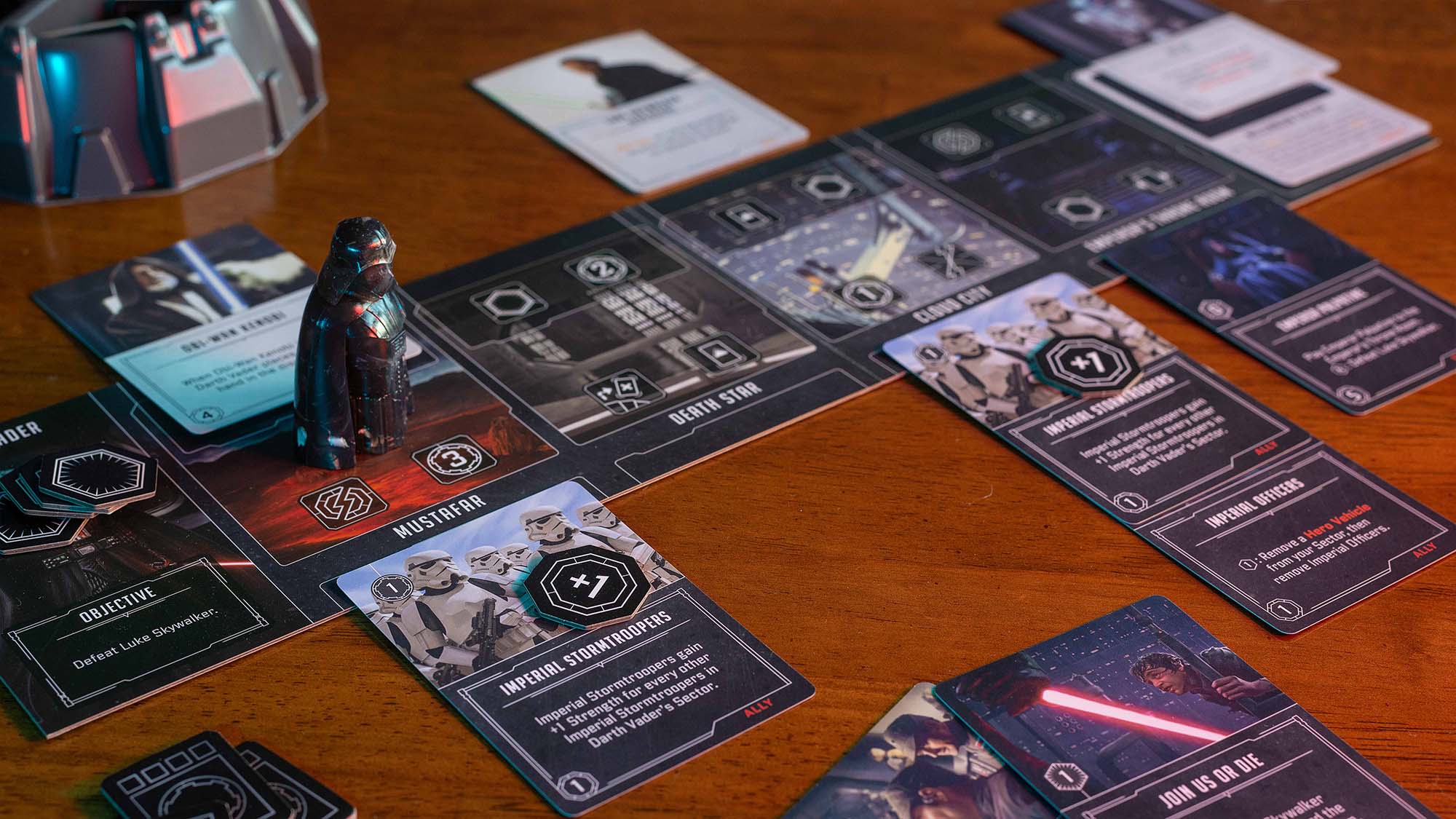
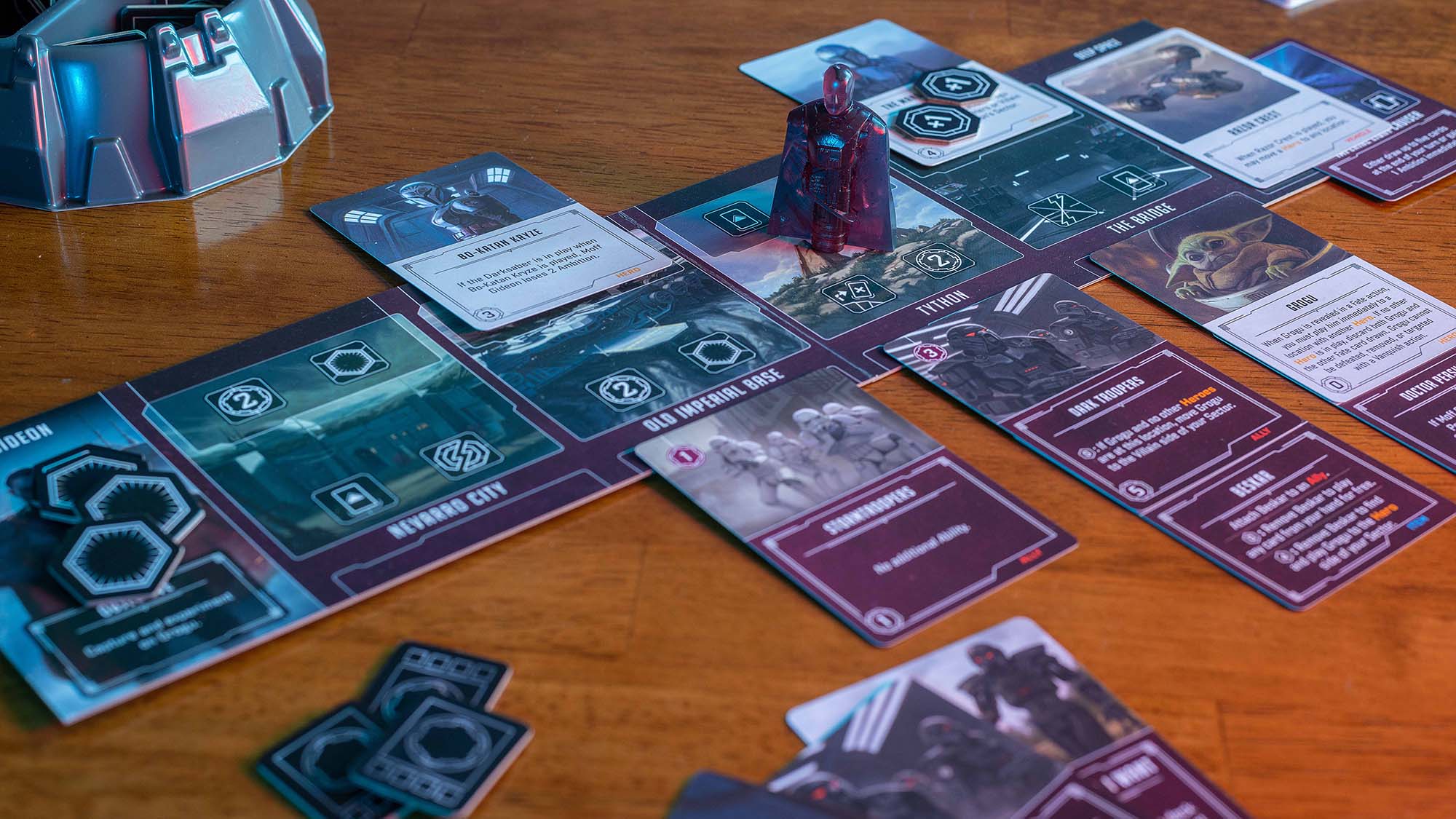
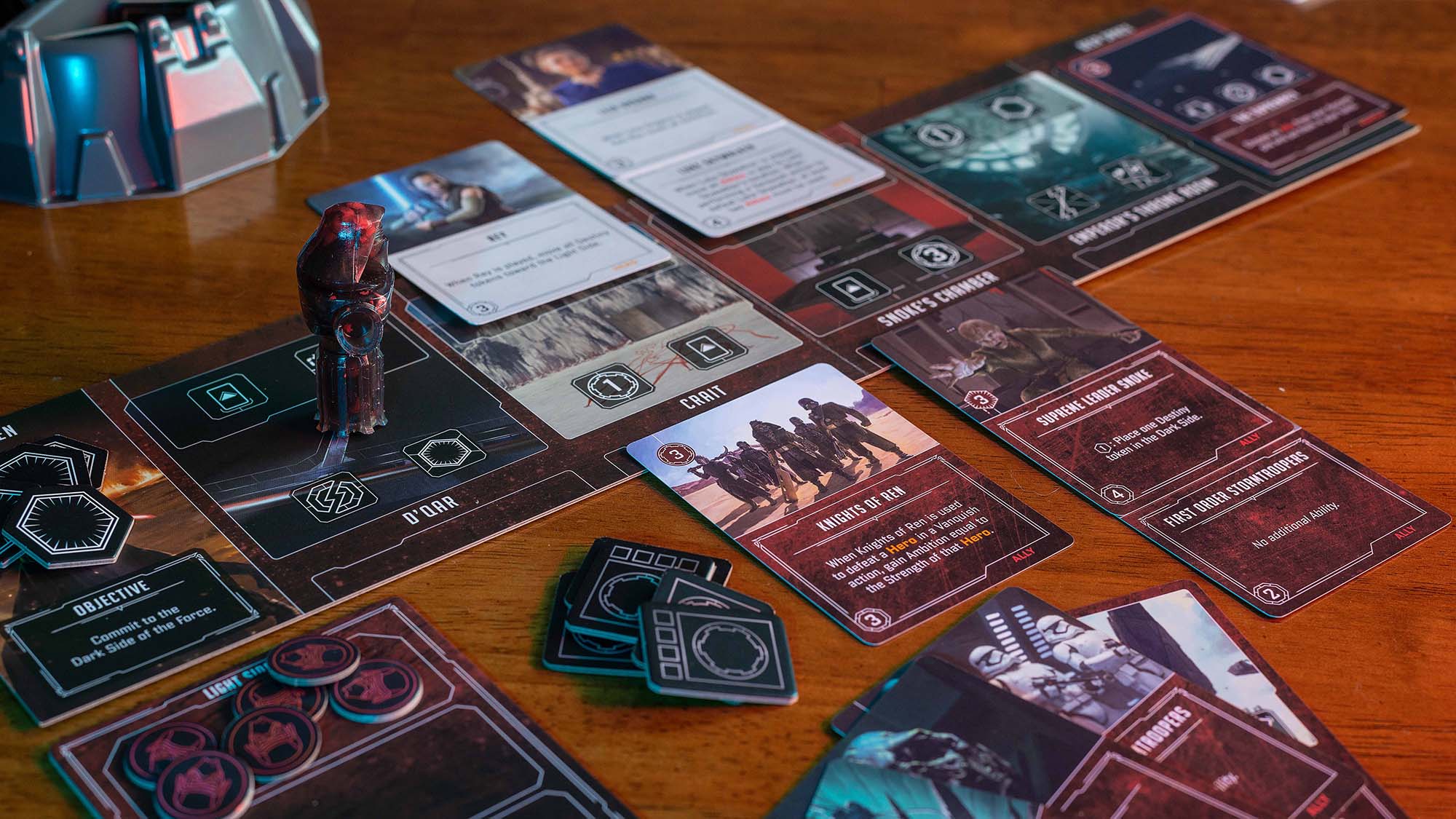
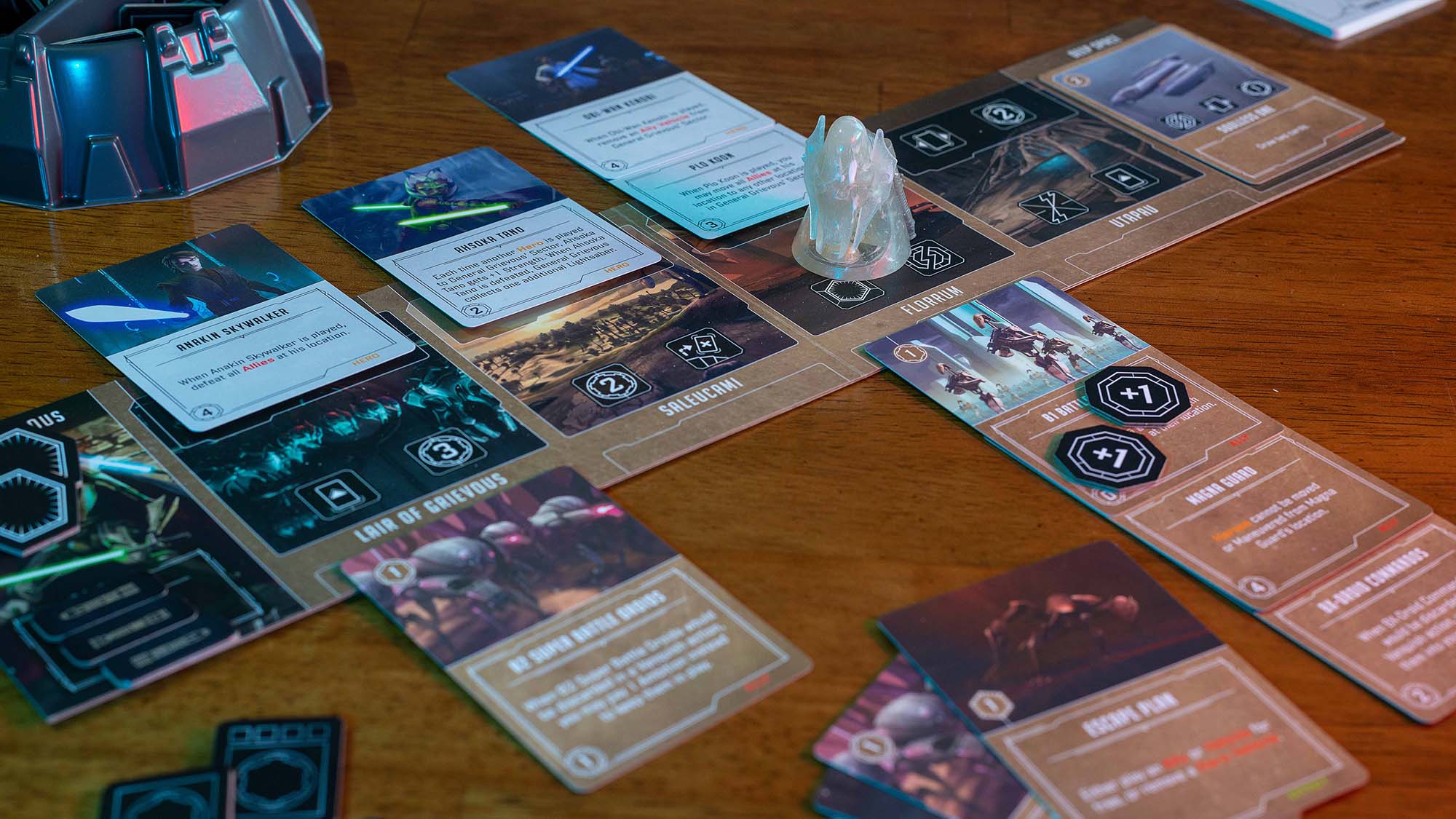
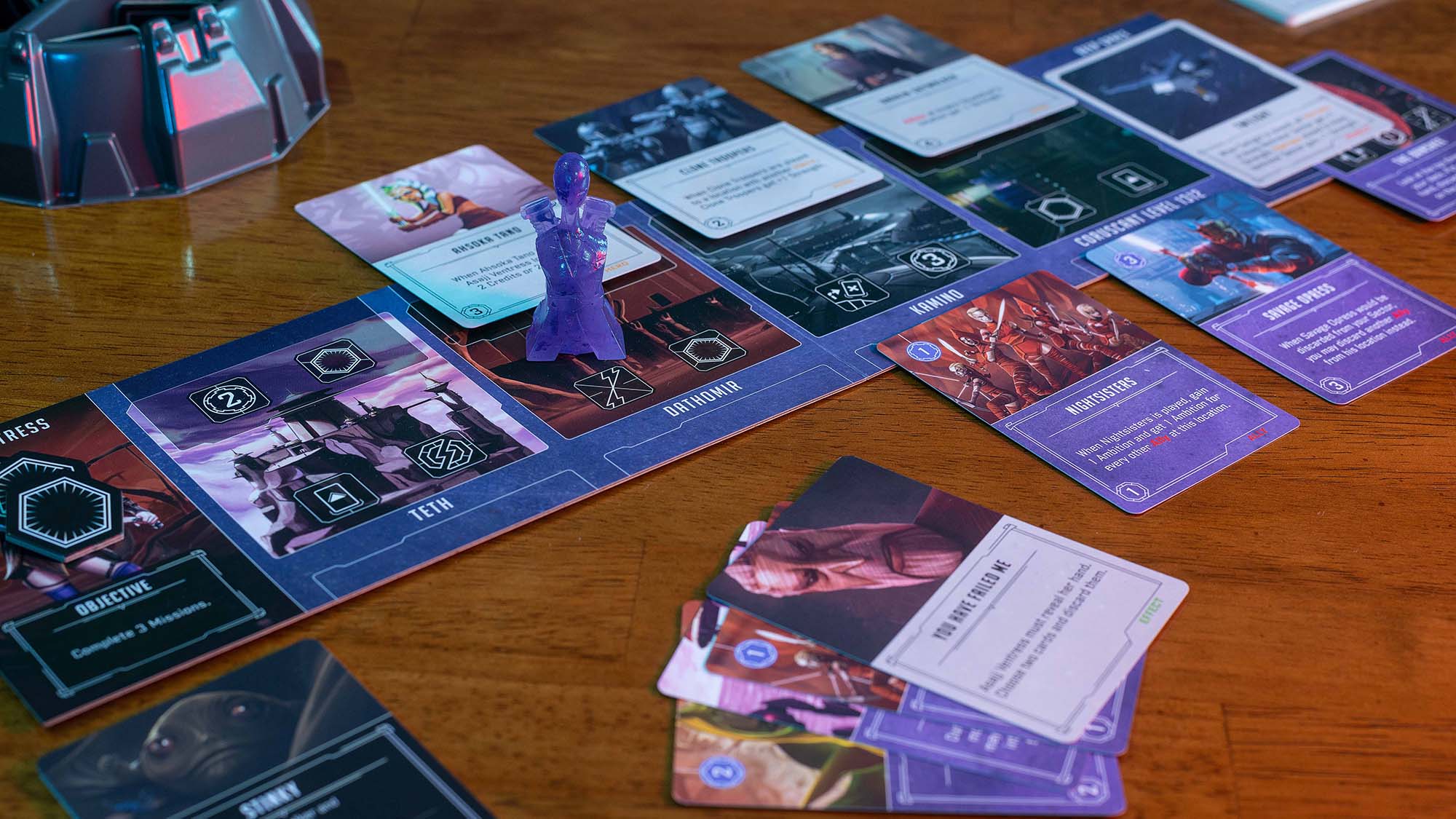
Just like any other Villainous game, Star Wars villains race to complete their unique objectives before any other player to win. During a typical turn, the player places the Villain Mover on a location they don’t currently occupy before performing as many actions as are available. Each location on the Sector contains four action icons, but some cards contain action icons too. However, Hero cards (found in the Fate deck) can be positioned over the top third of a sector to block the top two actions, until defeated.
Other Fate card categories are Effect, which tells you to do something such as; “Darth Vader loses up to 2 Ambition.” Item, which isn’t available in any current character’s Fate Deck. Restriction, which is essentially an ongoing effect that continues until a certain criteria is met to remove the card from play. And Vehicle (more on these cards later).
The Fate Deck is largely how players interact during the game. Rather than face off directly, they can use the Fate action to draw two cards from the deck. One is then chosen to disrupt their opponent’s villainous objectives and the other is discarded. While Fate cards generally disrupt your opponent, there’s a small chance element as they can occasionally help them too. General Grievous, for example, needs to collect the lightsabers of fallen Jedi heroes, so if you draw two Jedi heroes, you’ll be forced to place one on Grievous' Sector, which plays right into his hands.
In the same vein, Fate cards hinder some characters more than others. Darth Vader is particularly susceptible. During one game we drew Emperor Palpatine – who is crucial to completing the Dark Lord’s objectives – but before we could play him, Obi-Wan Kenobi was pulled from the Fate Deck. The Jedi’s ability forced us to send our entire hand to the discard pile, meaning a long, long wait before Palpatine would resurface.
Two major additions that sets Star Wars Villainous apart from its predecessors are the introduction of Ambition and Vehicles. The former acts as a second currency alongside Credit Tokens and is collected in a variety of ways including one token at the beginning of every turn. Some cards require Credits to play, while others require Ambition. The currency can also be used to activate card abilities and in some cases win the game – once other criteria are met.
The addition of Vehicle Cards makes a lot of sense in the Star Wars universe and adds another layer of strategy to the game, without overcomplicating the tried-and-tested Villainous formula. At the end of each Sector is an empty panel headed Deep Space, which is where Vehicles are played. Vehicles appear in both the Villain Deck and the Fate Deck. The former are of great use since uncontested vehicles become an additional location, complete with action icons, and an ability that’s activated upon arriving at the vehicle in question. The latter simply contains an ability and reduces the player’s hand by one card.
Things get a little tasty when opposing vehicles meet since they are what the game refers to as engaged. This process means the action icons can no longer be used, although the Villain Mover can still land on its own vehicles and activate their abilities. Once engaged the Vanquish Action can be used to remove both vehicles from play, although some cards from Villain Decks can also banish Fate vehicles.
Star Wars Villainous is an asymmetrical game so each character plays very differently and in doing so has their own advantages and disadvantages. That said, we managed to win a game with every character but Kylo Ren. His objective is to move all of his Destiny Tokens to the Dark Side on the Destiny Tracker. Simple enough, but young Ben Solo’s Fate Deck is particularly challenging.
General Grievous has the simplest objective, collect eight Lightsaber Tokens, mostly from Vanquishing (defeating) Jedi. However, Darth Vader is arguably the easiest character to play since his Villain Deck isn’t overly complicated to understand and flipping the Luke Skywalker Tile to its conflicted side and landing him in the Emperor’s Throne Room location with Emperor Palpatine himself and the Darth Vader mover is easier than it sounds. Asajj Ventress has to complete three missions from her five Mission Cards, which can prove a little complicated for new players.
However, perhaps the most satisfying character to play is also one of the hardest, Moff Gideon. The Mandalorian big bad is required to stick Baby Yoda, Doctor Pershing and an Item card called Laboratory Samples on the same location in the bottom half of the Sector. And with heroes such as Mando, Bo-Katan and Fennec Shand defending the youngster, it’s quite the feat. And yet, the Mando-themed decks are simply great fun to sift through and we feel all gooey inside every time we play little Grogu.
Villainous supports two to four players and although we had great fun playing with two, three is arguably the sweet spot. A lot can happen in a single turn so when four players are duking it out it’s perhaps best if the majority are familiar with the game to minimize downtime.
The game is at its malevolent best when you’re playing regularly with opponents who are familiar with every character on the table and can therefore strategize accordingly by gauging how close each player is to winning the game. One advantage of playing with three or more players is that it’s harder to pull ahead when multiple minds are keeping tabs on each other. This often results in a leading player receiving a combined barrage of Fate cards to slow them down, while a single opponent simply cannot deal out the same frequency of damage.
And yet when two players are in the zone a Villainous duel is a thrill all of its own. Cards are pulled, enemies are vanquished and evil deeds are achieved in quick succession. In fact, the game is often fast enough that you can comfortably play two or three rounds in a couple of hours. You may also find that some characters are more suited to two-player bouts than others. For example, Moff Gideon got stuck with a three-card hand due to an early vehicle placement and with no ally cards capable of bringing it down and Outland Tie Fighter and Imperial Light Cruiser at the bottom of the Villain deck, he had a severe disadvantage for the rest of the game and quickly succumbed to his single opponent.
The Star Wars theme will no doubt appeal to casual gamers and Villainous would be a decent introduction to the hobby or a step up for anyone looking for a slightly meatier gameplay experience than gateway games such as Ticket to Ride or Catan. Once everything’s laid out the game can look a little daunting, but those who jump in are largely rewarded thanks to informative cards that keep the game moving in the right direction. That said, we did find a few difficult-to-decipher examples where an extra word or two in an ability description would have made things less ambiguous.
SHOULD YOU BUY STAR WARS VILLAINOUS?
Star Wars Villainous is a fantastic entry in the Villainous board game series. The game’s 10+ age rating may prove a little optimistic for younger players as Ambition and Vehicles do add an extra layer of strategy to the classic Disney Villainous formula, but that’s certainly not a bad thing. Star Wars fans and existing Villainous players will lap up the on-point branding and additional depth.
Villainous’ genius is its inherent replay value as you feel compelled to try out each villain before refining your favorites. Even if you’re not a fan of the villain in question, their decks will be chocked full of characters and references from their respective timeline. So, Asajj Ventress may mean nothing to many casual Star Wars fans, but you’ll still get a kick when Yoda, Obi-Wan and Anakin appear on the table.
Some players might bemoan the solitaire-like feeling of presiding over your Villain’s Sector and never directly engaging other opponents, but we enjoy the Fate Deck's interesting competitive spin. There really is nothing like drawing a card and thwarting your opponent's evil deeds just as they’re about to win. The best strategists will be constantly engaged, keeping a close eye on what other players are doing.
Star Wars Villainous arguably boasts the best mechanics in the series, it’s just a shame that it’s lacking when it comes to presentation, in what is one of the most visually trendy board games series on the market. Villainous is one of the few tabletop titles where expansions – although certainly not essential – add flavor and variety without extending play times and muddying core rules. We can’t wait to see which Star Wars villains come next.
IF THIS PRODUCT ISN’T FOR YOU
If you’re itching to play a Villainous game but you hate the sand on Tatooine because it gets everywhere, then perhaps Marvel Villainous is more your style. The core game includes Thanos, Hela, Ultron, Killmonger and Taskmaster, while the classic Villainous gameplay is mixed up slightly with event cards, a shared Fate Deck and the Infinity Stones.
If you’re looking for an altogether meatier Star Wars board gaming experience that allows you to play out an alternative Original Trilogy, then consider introducing Star Wars Rebellion to the tabletop. This epic two-player romp tasks the Rebels with drumming up support across the galaxy while the Empire seeks to find and destroy their base.
Mike is a freelance writer for Space.com with over ten years experience. He also serves as Deputy Editor for N-Photo: The Nikon Magazine. As you might expect, he's an avid photographer, but he's also a bit of a sci-fi buff so you're just as likely to find him reviewing Star Wars Lego as the latest cameras.
